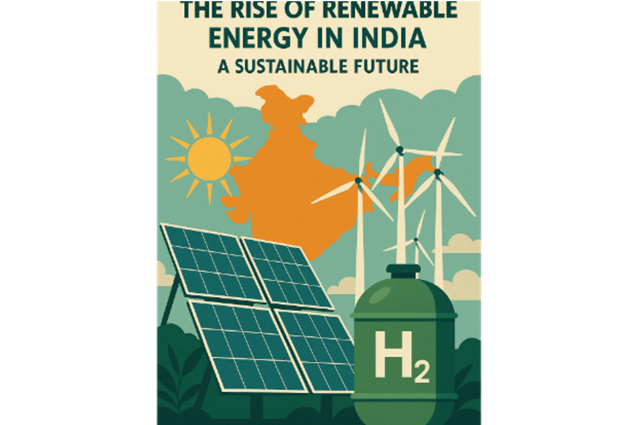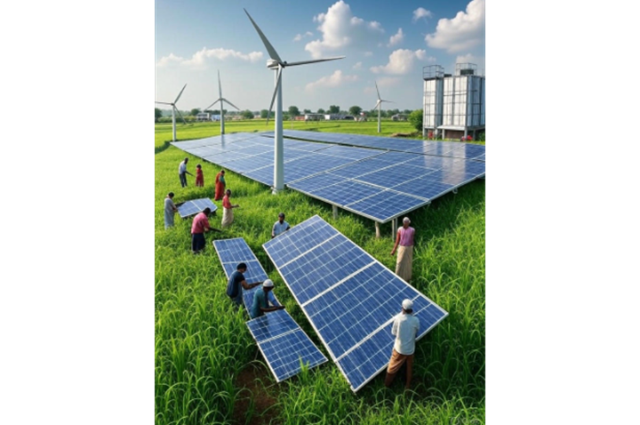
India is a country with 1.4 billion people. It aims to be the third-largest economy by 2030. The energy demand will double by 2040 due to urbanization and industrial growth. However, fossil fuels like coal and oil cause air pollution, climate change, and high import costs. Renewable energy, such as solar, wind, and green hydrogen, offers solutions. India targets 500 gigawatts (GW) of renewable energy by 2030, per the Paris Agreement. Challenges include infrastructure, economic issues, and social impacts. This article discusses renewable energy’s benefits, challenges, and solutions for India’s sustainable future.
Growth of Renewable Energy
India has made progress in renewable energy. By May 2025, it has over 200 GW of renewable capacity. Solar energy provides more than 100 GW, and wind energy provides 50 GW, per the Ministry of New and Renewable Energy (MNRE). Solar panel costs dropped 80% since 2010. Policies like the National Solar Mission and PM Suryaghar Yojana support growth. The Bhadla Solar Park in Rajasthan is a major project, showing India’s commitment.

Coal powers 50% of India’s electricity and causes problems. The 2024 State of Global Air report states air pollution leads to 2 million deaths yearly. Climate change brings heatwaves and floods. In 2024, Rajasthan faced 50°C heatwaves, and Assam had floods. People on X use hashtags like #CleanAirIndia to demand change. India’s 300 sunny days and wind resources make renewable energy viable.
Renewable energy creates jobs. It attracted $100 billion in investments since 2015 and created 1.2 million jobs, per MNRE. Jobs include solar panel production and wind turbine maintenance. This helps address the 23% youth unemployment rate, per CMIE (2023).
Benefits of Renewable Energy
Renewable energy offers benefits. It improves energy security. India spends $150 billion yearly on fossil fuel imports. Solar and wind projects in Gujarat and Tamil Nadu reduce this burden. This saves money. Renewable energy also helps the environment. India’s large population makes it a high emitter. Renewables can cut emissions by 45% by 2030, per NITI Aayog, supporting the 2070 net-zero goal. Heatwaves in 2024 reduced Punjab’s crop yields by 15%.

Renewable energy improves access. About 20% of rural households lack electricity. Solar microgrids help these areas. The Saubhagya Scheme brought power to many homes. Solar pumps in Bihar increased farmer incomes by 20%, according to 2024 studies. Renewable energy supports economic growth. Green bonds and partnerships bring investment. The PLI scheme reduces reliance on China, which supplies 70% of solar panels. Green hydrogen could add $15 billion to the economy by 2030.
Challenges to Overcome
Renewable energy faces challenges. Infrastructure is a major issue. Solar and wind need strong grids. India’s grid is old, causing rural outages. Upgrading needs $200 billion by 2030, per the Central Electricity Authority. This competes with other budget needs.
Land acquisition is difficult. Solar and wind projects need large areas, causing conflicts with farmers. In 2024, Gujarat protests stopped a 1 GW solar project. Agriculture supports 50% of India’s workforce. Financing is also a challenge. Projects need large initial investments. Small businesses face high interest rates. Reliance on Chinese panels creates risks.
Moving from coal affects jobs. Coal supports jobs in Jharkhand and Odisha. A 2023 study says 5 million coal jobs could be lost by 2035. In 2024, Chhattisgarh coal workers protested. Without retraining or new jobs, communities face economic distress. Skill gaps are another issue. India’s education system focuses on traditional subjects. Only 10% of technical graduates are ready for green tech jobs, per surveys. Rural youth lack training and internet access, increasing inequality.
Solutions for Success
India needs solutions to succeed. Policy changes are needed. The PLI scheme should expand to reduce foreign panel reliance. Coal subsidies of $10 billion yearly should shift to renewables. Tax incentives for green bonds can attract investment. Land acquisition needs clear processes. The 2024 Land Acquisition Act amendment helps but needs better implementation.
Training is important. The Skill India Mission can work with companies like Tata Power to train youth in solar and wind jobs. Tamil Nadu trained 50,000 youth since 2022, a good model. Online courses from Coursera and IITs can help. Innovation is key. Startups like ReNew Power work on battery storage to solve variability. Green hydrogen can change industries like steel. The International Solar Alliance aids technology transfer. France gave $1 billion to Indian solar in 2024.
Public awareness is important. X campaigns like #GreenIndia show youth support. Schools should teach climate change. Solar cooperatives in Gujarat earned $500,000 for farmers in 2023. Rural areas need focus. The PM Suryaghar Yojana reached 10 million homes in 2024 but needs better rural outreach.
India’s renewable energy path supports economic growth, environmental health, and social fairness. By 2030, renewables could power 50% of electricity, create jobs, and cut emissions. Rural areas and coal workers need support to avoid inequality. India, a Global South leader, can show progress at the 2025 COP30 summit. With policies, training, and innovation, India can succeed. Mahatma Gandhi said, “The earth has enough for everyone’s need, but not for everyone’s greed.” Renewable energy is India’s chance for a sustainable future.
Sources:
- Ministry of New and Renewable Energy (MNRE), 2025. Annual Report on Renewable Energy Capacity.
- International Energy Agency (IEA), 2024. World Energy Outlook.
- State of Global Air Report, 2024. Health Effects Institute.
- Centre for Monitoring Indian Economy (CMIE), 2023. Unemployment Rate in India.
- NITI Aayog, 2024. India’s Pathway to Net-Zero by 2070.
- Central Electricity Authority, 2023. Grid Infrastructure Requirements for 2030.
- X Platform, 2025. Hashtags #CleanAirIndia, #GreenIndia (May 23, 2025).
- National Hydrogen Mission, 2024. MNRE.
- The Economic Times, 2024. (Gujarat protests, Chhattisgarh coal protests).
- World Bank, 2024. Climate Impacts on Indian Agriculture.
. . .
